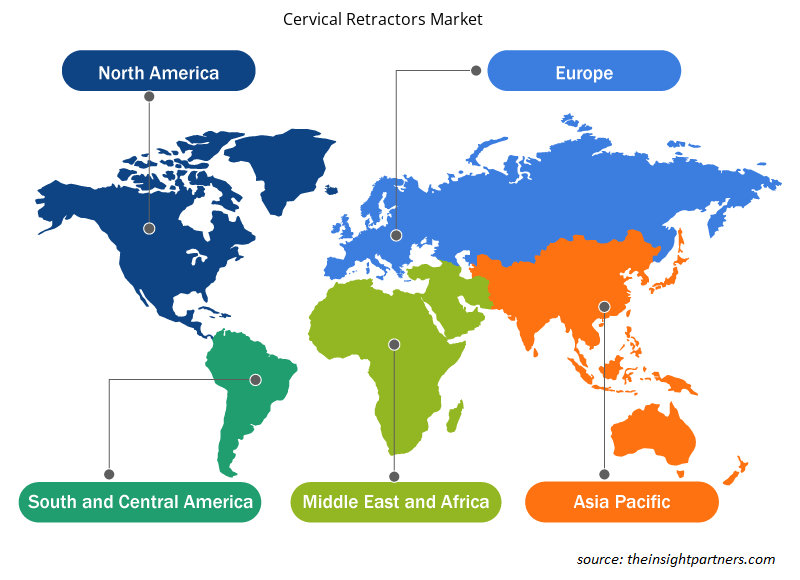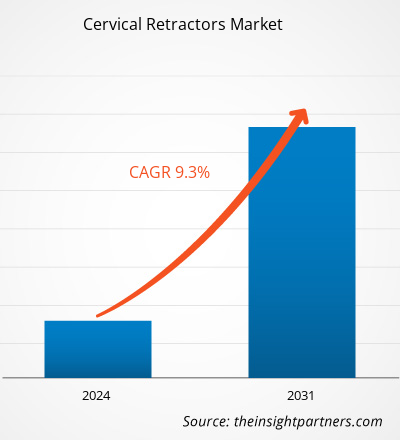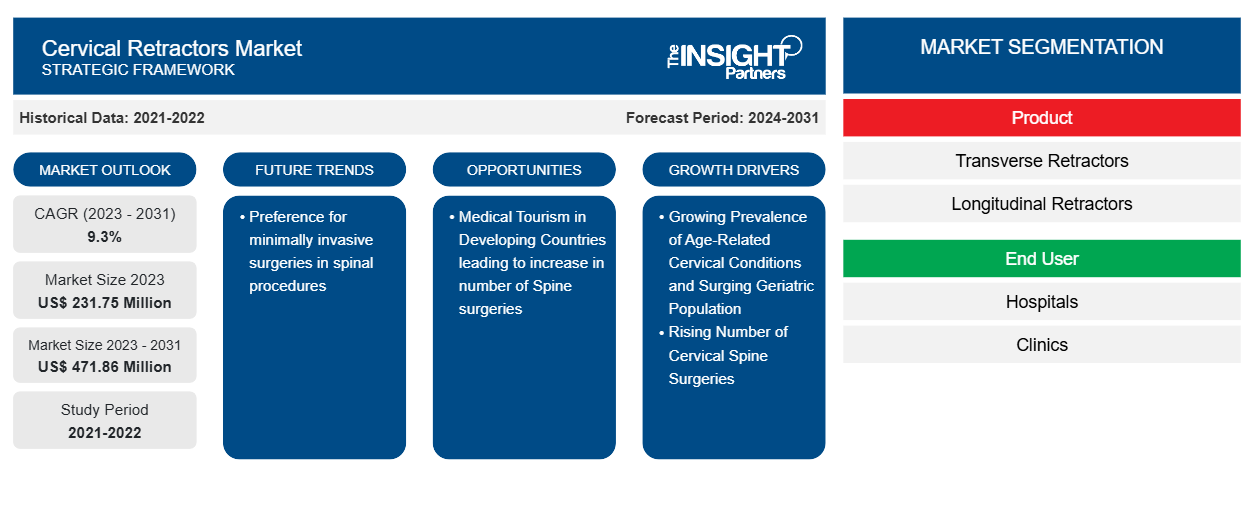Si prevede che il mercato dei retrattori cervicali raggiungerà i 471,86 milioni di dollari entro il 2031, rispetto ai 231,75 milioni di dollari del 2023. Si prevede che il mercato registrerà un CAGR del 9,3% nel periodo 2023-2031. È probabile che la preferenza per gli interventi chirurgici minimamente invasivi rimanga una tendenza chiave nel mercato.
Analisi di mercato dei retrattori cervicali
L'aumento dell'incidenza di disturbi della colonna cervicale come stenosi spinale, disturbi degenerativi e lesioni traumatiche, i progressi tecnologici nei dispositivi chirurgici e la crescente popolazione geriatrica stanno alimentando la crescita del mercato dei retrattori cervicali. Anche l'attuale sviluppo delle infrastrutture sanitarie nei paesi in via di sviluppo e il crescente numero di procedure chirurgiche spinali stanno alimentando la crescita del mercato dei retrattori cervicali.
Panoramica del mercato dei retrattori cervicali
Geograficamente, si prevede che l'Asia Pacifica registrerà il CAGR più elevato nel periodo di previsione 2023-2031. L'India è tra le nazioni in più rapido sviluppo al mondo ed è tra i principali paesi leader dell'Asia Pacifica. L'India ospita circa il 17% della popolazione mondiale totale. Si prevede che il mercato dei retrattori cervicali prospererà durante il periodo di previsione a causa di un aumento della prevalenza di lesioni del midollo spinale, della crescente popolazione geriatrica e delle attività di ricerca in corso in tutto il paese. Secondo un articolo pubblicato, circa 1,5 milioni di persone in India vivono con lesioni del midollo spinale. Secondo Narayana Health, l'incidenza annuale media di lesioni spinali in India è di 15.000. La popolazione geriatrica è più suscettibile alle lesioni del midollo spinale e quindi si prevede che sosterrà la domanda di retrattori cervicali. Ad esempio, nel 2021, il paese ha registrato quasi 138 milioni di anziani, di cui 67 milioni di uomini e 71 milioni di donne. Pertanto, è probabile che il rapido aumento della popolazione geriatrica in tutto il Paese stimoli la crescita del mercato durante il periodo di previsione.
Personalizza questo report in base alle tue esigenze
Riceverai la personalizzazione gratuita di qualsiasi report, comprese parti di questo report, o analisi a livello nazionale, pacchetto dati Excel, oltre a usufruire di grandi offerte e sconti per start-up e università
-
Scopri le principali tendenze di mercato in questo rapporto.Questo campione GRATUITO includerà analisi di dati che spaziano dalle tendenze di mercato alle stime e alle previsioni.
Driver e opportunità di mercato per i retrattori cervicali
Aumento del numero di interventi chirurgici alla colonna cervicale a favore del mercato
La malattia degenerativa del disco cervicale non è tecnicamente una malattia, ma piuttosto una descrizione del processo degenerativo che attraversano i dischi situati nella colonna cervicale. In sostanza, tutte le persone che vivono abbastanza a lungo svilupperanno dischi degenerati. Diversi studi suggeriscono che molti adulti non mostrano sintomi di malattia degenerativa del disco, anche se un'alta percentuale di loro manifesta ancora i segni di degenerazione del disco sulla colonna vertebrale, in una risonanza magnetica. Secondo uno degli studi, circa il 50% delle persone inizia a mostrare alcuni segni di degenerazione del disco in una risonanza magnetica all'inizio dei loro 20 anni. Un altro studio ha scoperto che circa il 75% delle persone di età inferiore ai 50 anni ha una degenerazione del disco, mentre oltre il 90% delle persone di età pari o superiore ai 50 anni ha la malattia degenerativa del disco. Mentre quasi tutti alla fine contraggono la malattia degenerativa del disco cervicale con l'età, fattori come la genetica, l'obesità e il fumo accelerano il processo di sviluppo di questa malattia, in modo che le persone diventino sintomatiche prima. Pertanto, un aumento del numero di interventi chirurgici alla colonna cervicale sta alimentando la crescita del mercato dei retrattori cervicali.
L'aumento del turismo medico nei paesi in via di sviluppo rappresenta un'opportunità per la crescita del mercato
I pazienti viaggiano in altri paesi grazie a dispositivi, attrezzature e altri prodotti di tecnologia medica avanzata e sofisticata. Il turismo medico è in crescita nell'Asia Pacifica, dove l'India sta emergendo come una destinazione favorevole grazie alle opportunità chiave disponibili nel paese sotto forma di infrastrutture e tecnologie efficienti nel suo settore sanitario. I sistemi medici nazionali e il mercato dell'assicurazione sanitaria sono ben sviluppati a livello globale, il che lo rende conveniente per i visitatori dall'Occidente e dal Medio Oriente. Inoltre, le spese ospedaliere sono inferiori in India rispetto a quelle nei paesi occidentali. Inoltre, molti paesi europei stanno diventando destinazioni per il turismo medico. La Polonia è una delle destinazioni di turismo medico di maggior successo che attrae un gran numero di pazienti. Il costo delle procedure chirurgiche è inferiore a quello di molti altri paesi. Offrire interventi chirurgici critici a costi più bassi aumenta il flusso di pazienti in questi paesi per i loro trattamenti medici. Inoltre, la disponibilità di tecniche mediche avanzate e l'aumento dei finanziamenti governativi per aumentare il turismo medico stanno portando alla crescente domanda di impianti chirurgici avanzati . Inoltre, l'avanzata infrastruttura sanitaria nei paesi in via di sviluppo probabilmente continuerà la domanda di dispositivi medici avanzati, migliorando le opportunità di crescita per il mercato dei dispositivi di fusione spinale. La crescita del turismo medico nei paesi emergenti offre notevoli opportunità di crescita agli operatori che operano nel mercato dei divaricatori cervicali.
Analisi della segmentazione del rapporto di mercato dei retrattori cervicali
I segmenti chiave che hanno contribuito alla derivazione dell'analisi di mercato dei retrattori cervicali sono il prodotto e l'utente finale.
- In base al prodotto, il mercato dei retrattori cervicali è suddiviso in retrattori trasversali e retrattori longitudinali. Il segmento dei retrattori trasversali ha detenuto una quota di mercato maggiore nel 2023.
- In base all'utente finale, il mercato dei retrattori cervicali è suddiviso in ospedali, cliniche e altri. Il segmento ospedaliero ha detenuto la quota di mercato maggiore nel 2023.
Analisi della quota di mercato dei retrattori cervicali per area geografica
L'ambito geografico del rapporto sul mercato dei retrattori cervicali è suddiviso principalmente in cinque regioni: Nord America, Asia Pacifico, Europa, Medio Oriente e Africa, e Sud e Centro America.
Il Nord America ha dominato il mercato. La crescita in Nord America è caratterizzata dall'aumento della domanda di retrattori cervicali da parte di ospedali e cliniche, dal crescente numero di pazienti sottoposti a procedure minimamente invasive, dall'elevata consapevolezza dei pazienti, da uno scenario di rimborso favorevole e dalla spesa più elevata in sanità. Inoltre, l'aumento della popolazione geriatrica, il crescente numero di malattie croniche e il crescente numero di lesioni alla colonna vertebrale tra i paesi della regione probabilmente spiegheranno la crescita del mercato dei retrattori cervicali nordamericani durante gli anni previsti. Secondo il National Spinal Cord Injury Statistical Center, l'incidenza annuale di lesioni traumatiche del midollo spinale (tSCI) è di circa 54 casi un milione di persone negli Stati Uniti, il che equivale a circa 18.000 nuovi casi di tSCI ogni anno. Secondo un articolo "Statistiche sulle lesioni del midollo spinale degli Stati Uniti del 2023", circa 302.000 persone negli Stati Uniti hanno sperimentato tSCI. La crescente prevalenza di tSCI negli Stati Uniti sta alimentando la crescita del mercato dei retrattori cervicali nordamericani.
Approfondimenti regionali sul mercato dei retrattori cervicali
Le tendenze regionali e i fattori che influenzano il mercato dei retrattori cervicali durante il periodo di previsione sono stati ampiamente spiegati dagli analisti di Insight Partners. Questa sezione discute anche i segmenti e la geografia del mercato dei retrattori cervicali in Nord America, Europa, Asia Pacifico, Medio Oriente e Africa e Sud e Centro America.

- Ottieni i dati specifici regionali per il mercato dei retrattori cervicali
Ambito del rapporto di mercato sui retrattori cervicali
| Attributo del report | Dettagli |
|---|---|
| Dimensioni del mercato nel 2023 | 231,75 milioni di dollari USA |
| Dimensioni del mercato entro il 2031 | 471,86 milioni di dollari USA |
| CAGR globale (2023-2031) | 9,3% |
| Dati storici | 2021-2022 |
| Periodo di previsione | 2024-2031 |
| Segmenti coperti |
Per Prodotto
|
| Regioni e Paesi coperti |
America del Nord
|
| Leader di mercato e profili aziendali chiave |
|
Densità dei player del mercato dei retrattori cervicali: comprendere il suo impatto sulle dinamiche aziendali
Il mercato dei retrattori cervicali sta crescendo rapidamente, spinto dalla crescente domanda degli utenti finali dovuta a fattori quali l'evoluzione delle preferenze dei consumatori, i progressi tecnologici e una maggiore consapevolezza dei benefici del prodotto. Con l'aumento della domanda, le aziende stanno ampliando le loro offerte, innovando per soddisfare le esigenze dei consumatori e capitalizzando sulle tendenze emergenti, il che alimenta ulteriormente la crescita del mercato.
La densità degli operatori di mercato si riferisce alla distribuzione di aziende o società che operano in un particolare mercato o settore. Indica quanti concorrenti (operatori di mercato) sono presenti in un dato spazio di mercato in relazione alle sue dimensioni o al valore di mercato totale.
Le principali aziende che operano nel mercato dei retrattori cervicali sono:
- Sistemi di impianti Aesculap LLC
- Innovazioni chirurgiche TeDan
- Medfix Internazionale LLC
- Globus Medical, Inc.
- Sistemi sanitari NSI
- Chirurgia Thompson
Disclaimer : le aziende elencate sopra non sono classificate secondo un ordine particolare.

- Ottieni una panoramica dei principali attori del mercato dei retrattori cervicali
Notizie di mercato e sviluppi recenti sui retrattori cervicali
Il mercato dei retrattori cervicali viene valutato raccogliendo dati qualitativi e quantitativi dopo la ricerca primaria e secondaria, che include importanti pubblicazioni aziendali, dati di associazioni e database. Di seguito sono elencati alcuni degli sviluppi nel mercato dei retrattori cervicali:
- SURE Retractors Inc. ha annunciato il primo utilizzo della sua ultima aggiunta alla linea di prodotti, un nuovo retrattore cervicale anteriore e posteriore sterile. I retrattori radiotrasparenti SURE sono monouso, pronti per l'intervento chirurgico, confezionati in modo sterile e facili da usare. (Fonte: SURE Retractors Inc., comunicato stampa, ottobre 2023)
- SURE Retractors Inc ha lanciato la sua ultima aggiunta alla linea di prodotti, Sunoptic Surgical Light Wand. Sunoptic Surgical Light Wand è una fonte di luce monouso, sterile e preconfezionata che illumina il sito della ferita dall'interno della ferita. Il dispositivo all'avanguardia è progettato per fornire un'illuminazione di alta qualità per le procedure chirurgiche, offrendo al contempo a ospedali e cliniche una fonte di luce conveniente. (Fonte: SURE Retractors Inc., comunicato stampa, giugno 2023)
Copertura e risultati del rapporto di mercato sui retrattori cervicali
Il rapporto "Dimensioni e previsioni del mercato dei retrattori cervicali (2021-2031)" fornisce un'analisi dettagliata del mercato che copre le seguenti aree:
- Dimensioni e previsioni del mercato dei retrattori cervicali a livello globale, regionale e nazionale per tutti i principali segmenti di mercato coperti dall'ambito
- Tendenze del mercato dei retrattori cervicali e dinamiche di mercato come driver, sistemi di ritenuta e opportunità chiave
- Analisi dettagliata delle cinque forze PEST/Porter e SWOT
- Analisi di mercato dei retrattori cervicali che copre le principali tendenze del mercato, il quadro globale e regionale, i principali attori, le normative e i recenti sviluppi del mercato
- Analisi del panorama industriale e della concorrenza che copre la concentrazione del mercato, l'analisi della mappa di calore, i principali attori e gli sviluppi recenti per il mercato dei retrattori cervicali
- Profili aziendali dettagliati
- Analisi storica (2 anni), anno base, previsione (7 anni) con CAGR
- Analisi PEST e SWOT
- Valore/volume delle dimensioni del mercato - Globale, Regionale, Nazionale
- Industria e panorama competitivo
- Set di dati Excel
Report recenti
Testimonianze
Motivo dell'acquisto
- Processo decisionale informato
- Comprensione delle dinamiche di mercato
- Analisi competitiva
- Analisi dei clienti
- Previsioni di mercato
- Mitigazione del rischio
- Pianificazione strategica
- Giustificazione degli investimenti
- Identificazione dei mercati emergenti
- Miglioramento delle strategie di marketing
- Aumento dell'efficienza operativa
- Allineamento alle tendenze normative























 Ottieni un campione gratuito per - Mercato dei divaricatori cervicali
Ottieni un campione gratuito per - Mercato dei divaricatori cervicali